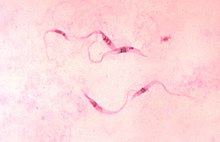Kinetoplastida
| Kinetoplastida | |
|---|---|
 |
|
| Trypanosoma cruzi parasites | |
| Scientific classification | |
| Domain: | Eukaryota |
| (unranked): | Excavata |
| Phylum: | Euglenozoa |
| Class: |
Kinetoplastida Honigberg, 1963 |
| Orders | |
| Synonyms | |
|
Kinetoplastea Cavalier-Smith, 1981 |
|
Kinetoplastea Cavalier-Smith, 1981
Kinetoplastida (or Kinetoplastea, as a class) is a group of flagellated protists belonging to the phylum Euglenozoa, and characterised by the presence of an organelle with a large massed DNA called kinetoplast (hence the name). The organisms are commonly referred to as "kinetoplastids" or "kinetoplasts" The group includes a number of parasites responsible for serious diseases in humans and other animals, as well as various forms found in soil and aquatic environments. Their distinguishing feature, the presence of a kinetoplast, is an unusual DNA-containing granule located within the single associated with the base of the cell's flagella (the basal body). The kinetoplast contains many copies of the mitochondrial genome.
The kinetoplastids were first defined by Bronislaw M. Honigberg in 1963 as the members of the flagellated protozoans. They are traditionally divided into the biflagellate Bodonidae and uniflagellate Trypanosomatidae; the former appears to be paraphyletic to the latter. One family of kinetoplastids, the trypanosomatids, is notable as it includes several genera which are exclusively parasitic. Bodo is a typical genus within kinetoplastida and including various common free-living species which feed on bacteria. Others include Cryptobia and the parasitic Leishmania.
Bronislaw M. Honigberg created the taxonomic names Kinetoplastida and Kinetoplastea in 1963. Since then there is no consensus on the use of either of the two as a definite taxon. Kinetoplastea is more widely used as the class. While Kinetoplastida is mostly used to designate the order, but is also used as a class.Lynn Margulis, who initially accepted Kinetoplastida as an order in 1974, later placed it as a class. Use of Kinetoplastida as an order also creates confusion as there is already an older name Trypanosomatida Kent, 1880, under which the kinetoplastids are most often placed.
...
Wikipedia
